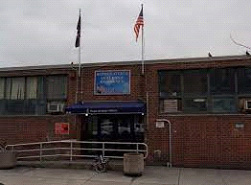- Home
- Our Newspaper
- News
- Be the Story - Borden Ave Veterans Residence Part 2
Be the Story - Borden Ave Veterans Residence Part 2
I arrived in New York City on Tuesday, July 26, to meet a new friend and participate in the filming of a documentary on vulnerable veterans with Let’s Rethink This founder Jerry Ashton and acclaimed documentarist and photographer Patrick de Warren.
 While I had been planning a move from Phoenix for some time, I had no idea when, where, or how. It wasn’t until I woke up that second morning in a hotel in Chinatown that I realized how happy I was when I lived in Chicago during the 90’s. I had already started the intake at the 30th St. Shelter, so I was familiar with the process. That’s the good thing about veterans, most of us can be dropped off in the middle of nowhere and fend for ourselves. Had I not needed my birth certificate and social security card, I wouldn’t have needed to return to Arizona at all. In retrospect, it was necessary to return, but at a cost to my present living conditions at the Borden Ave. Veterans’ Residence, or BAVR, after an A/C repair necessitated giving up my cubicle to another veteran while I was in Arizona.
While I had been planning a move from Phoenix for some time, I had no idea when, where, or how. It wasn’t until I woke up that second morning in a hotel in Chinatown that I realized how happy I was when I lived in Chicago during the 90’s. I had already started the intake at the 30th St. Shelter, so I was familiar with the process. That’s the good thing about veterans, most of us can be dropped off in the middle of nowhere and fend for ourselves. Had I not needed my birth certificate and social security card, I wouldn’t have needed to return to Arizona at all. In retrospect, it was necessary to return, but at a cost to my present living conditions at the Borden Ave. Veterans’ Residence, or BAVR, after an A/C repair necessitated giving up my cubicle to another veteran while I was in Arizona.
 While I was provided a cubicle when I arrived back on August 20th, I neglected to request to be reinstated in the program on Monday. Then on Tuesday, I was again moved for another veteran, but this time to one of five open bays which consist of beds and lockers. The bays are there for the veterans which may not be eligible for VA services, or in the process of applying or filing a claim. This allows even the veteran unable to receive services such as HUD/VASH, but prevents them from being surrounded by other veterans, supportive staff, counselors, and security. This is still New York after all, and both shelters I have stayed at have strict security, at the entrance and throughout the facility.
While I was provided a cubicle when I arrived back on August 20th, I neglected to request to be reinstated in the program on Monday. Then on Tuesday, I was again moved for another veteran, but this time to one of five open bays which consist of beds and lockers. The bays are there for the veterans which may not be eligible for VA services, or in the process of applying or filing a claim. This allows even the veteran unable to receive services such as HUD/VASH, but prevents them from being surrounded by other veterans, supportive staff, counselors, and security. This is still New York after all, and both shelters I have stayed at have strict security, at the entrance and throughout the facility.
While it has been a pain being shuffled around, it does show how each cog in the wheel of New York City Homeless Services works around the clock 24/7 to provide a warm meal, a change of clothes, and a safe space for those suffering homelessness from mental illness, criminal history, loss of income, or any number of other factors that render 40,000 veterans on American streets on any given night. There are approximately 240 veterans at BAVR facility alone, so each agency that is doing its part to keep the services and resources moving along is a key to success for the New York Shelter Services, but more importantly for the at-risk veteran. It is an efficient process of transitioning the veteran experiencing homelessness into a safe environment and on the road to success.
This policy of transitioning also allows the veteran to return to the shelter at any time and only need to be reinstated in the program and assigned a bed. For those veterans that are eligible for VA Benefits, the same rules apply to the Grant Per Diem program of three stays in their lifetime. But for the veteran struggling with addiction and mental health issues they are able to come and go as they please. For the veteran that has to leave for family matters and/or employment, they can return to the program at any time. Depending on eligibility, VA Benefits are either reinstated or continued, like what has happened with me since returning from Arizona to tie up loose ends there. After being reinstated into BAVR and assigned a bed in one of the open bays, next, I will be assigned a cubicle and continue the HUD/VASH program where we left off before going to Phoenix.
Latest Articles
Latest Interviews
By Contributor:

Tim Pena
In October 2014, after being arrested for felony driving under the influence and awaiting to be bailed out from the Veteran’s ‘pod’ at Maricopa County Jail, and as my cell was next to the phones, I happened to overhear a heated discussion between a fellow veteran and someone else. Two hours later, that veteran took apart a razor blade, slit his throat and committed suicide. After release and returning home, I spent three days with a construction razor blade in my hand trying to figure out how to join ‘Club 22’ without getting blood everywhere. What followed after was tearing down the protective wall I had built up over 30 years since discharge and then 2 1/2 years of treatment, medication reevaluation and adjustment, diagnosis, and peer-to-peer interaction with other veterans in similar situations.










